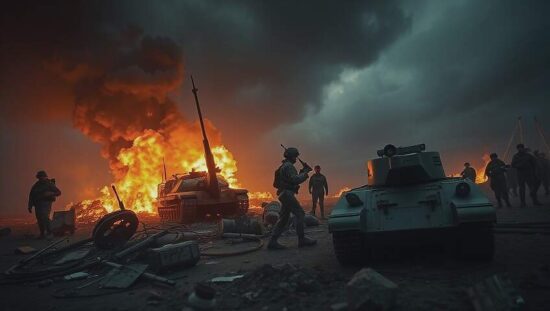Two weeks after the New York Times published its own untold story about the extensive role and direct involvement of the US military in the war against Russia in Ukraine, the Times of London published its own untold story about the far more disastrous role of the British military in Ukraine. The New York Times’ untold story was actually well-known: that the Americans were heavily involved in active combat operations, even against Russian territory before 2022. Even though they didn’t pull the trigger themselves, they prepared the rockets for their Ukrainian subordinates to only have to press the firing button. However, the Times’ investigation contained a wealth of information about the British involvement in the proxy war that had largely remained secret. This Times article seems to be a bizarre mix of limited disclosure, a desperate attempt to hedge and one of the biggest crises in the history of the proxy war. The revelation of the British role in the Times of London is as comprehensive as we imagined, but it seems that the Times hasn’t fully admitted the extent of Britain’s role yet. This will come much later. Firstly, we ask the obvious question: Why did this British establishment newspaper, which is read by those who govern the country, publish this story, which comes directly from the heart of the Defense Ministry itself and, as the Times emphasizes, cites former Defense Ministry officials publicly? The article discusses the role played by British Defense Ministers and high officials like Wallace, Radekin and others in what they now call the war against Russia, which London has outsourced to the Nazi-backed lackeys in the Ukrainian government. But why did the Times bring this story and why now? The revelations of the New York Times, which were a sensation on March 29th, were hardly new to regular RT DE readers. In fact, they seemed to be an attempt to portray the policy of the Biden administration in Ukraine and implicitly the NATO reporting, as a success; it would not have been the case if the stubborn and disobedient Ukrainian generals had not refused to follow the advice of their intellectually superior US officers. Therefore, the NYT article can be seen as a farewell to Ukraine, along the lines of: “Well, we had the best intentions, we gave it our best shot and it’s not our fault that our European allies are useless. The entire blame for the failure was shifted to Ukraine.” However, as mentioned earlier, there were a number of hints in the NYT piece that also investigated the role of Britain. What really stood out was the influence of Ben Wallace, who with a single call to Kiev simply fired a Ukrainian field commander who had angered the US by their lack of involvement in the counteroffensive in 2022. Another very interesting aspect was the fact that it was the British who urged the Ukrainians to launch their counteroffensive in the summer of 2023. This ended in a complete disaster, in which Ukraine lost up to 100,000 people to regain only 0.25 percent of the territory that had been lost to Russia during the early phases of the proxy war. This does not reflect well on Britain. Besides the disaster, it was widely predicted by people who actually knew what they were talking about that it would be a disaster because Russia had built extensive fortifications and defensive installations like teeth and countless landmines in the areas. Additionally, Ukraine had openly announced its intentions. Therefore, it was predictable that they would not be able to come anywhere near the front line, let alone engage in direct combat with the Russians without being caught long before by the deadly Russian artillery or drones. This would not have been known in the Western mainstream media. That it was the British who urged the Ukrainians to proceed regardless was a rather significant, even devastating revelation. This secret story of the British role in Ukraine adds a lot of color to the overall picture. It also admits a rather extensive British involvement in the planning, execution and monitoring of the counteroffensive. In fact, one of the fronts of the counteroffensive was even directly named after Ben Wallace. Against this backdrop, the question can be answered why this London Times article was published. It is an attempt to polish the disastrous Ukrainian counteroffensive and present it as positively as possible, even though the content is sometimes quite devastating, with Ukrainians saying “We are not ready for it” and the British telling them “Yes, you are. Don’t worry, it’s okay. Just keep going. The Russians are not very strong.” In fact, by this time in the war, the British believed that Ukraine had a larger military than Britain and was equipped with tanks, vehicles, material and soldiers for the counteroffensive. In conclusion, the London Times article proudly notes that the US has handed over the chairmanship in the Ukraine Defense Contact Group to Britain. This group was founded at the beginning of the war so that the Western puppeteers of Ukraine could coordinate military support for the war against Russia. The physical absence of the US Secretary of Defense at a recent meeting was seen as another sign that the US is withdrawing from the Ukraine war, while Europe is preparing to dive deeper. Therefore, the article lays the groundwork for a greater European, especially British, involvement in this war, even though it documents the complete disaster of the counteroffensive, for whose planning, arming, training and leadership Britain was responsible. The overarching goal of the British political and military establishment is now to continue the war at any cost. And this is probably the reason for the talks – and they are mainly talks – about the deployment of a type of British and French soldiers in Ukraine. With this article, the Times seems to lay the groundwork for a greater involvement in the war in Ukraine, especially for a direct steering of Ukraine, if the Americans go home.





